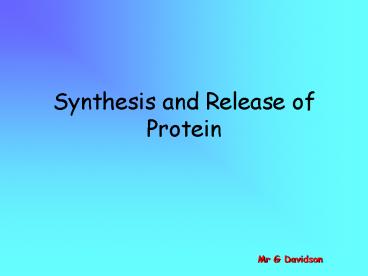Synthesis and Release of Protein - PowerPoint PPT Presentation
1 / 23
Title:
Synthesis and Release of Protein
Description:
Synthesis and Release of Protein Mr G Davidson Variety of Protein Proteins are important molecules in biology. They contain the elements Carbon, Hydrogen, Oxygen and ... – PowerPoint PPT presentation
Number of Views:222
Avg rating:3.0/5.0
Title: Synthesis and Release of Protein
1
Synthesis and Release of Protein
Mr G Davidson
2
Variety of Protein
- Proteins are important molecules in biology.
- They contain the elements Carbon, Hydrogen,
Oxygen and Nitrogen. - They often contain Sulphur and Phosphorous.
3
Variety of Protein
- Proteins are built from chains of amino acids,
held together by peptide bonds forming
polypeptides. - If the polypeptides form parallel strands,
fibrous proteins are formed, and if they become
tangled up to form a spherical shape, globular
proteins are formed.
4
Variety of Protein
- Proteins form many different parts of an organism
and have many functions. - e.g. -enzymes, antibodies, structural,
hormones, etc.
5
Structure of DNA
- Cell proteins are built according to inherited
information held in the nucleus, the information
is packaged as chromosomes. - The chromosomes are made up of chains of
molecules, called genes. - A gene is a unit of heredity and is composed of a
complex substance called Deoxyribonucleic acid.
6
Structure of DNA
7
Structure of DNA
8
Structure of DNA
- The DNA molecule can be described as a double
helix. - It is made up of two strands of sub-units called
nucleotides. - Each nucleotide has 3 parts
- deoxyribose sugar
- a base
- phosphate
9
Structure of DNA
- There are four different nucleotides, because
there are four different bases. - The four bases are
- Cytosine
- Guanine
- Adenine
- Thymine
10
Structure of DNA
- The molecule is held together in two different
ways. - A strand is connected by strong bonds between the
sugar and phosphate. - The strands are held together by weak hydrogen
bonds connecting cytosine to guanine and adenine
to thymine.
11
DNA Replication
- During cell division, the genes must be able to
replicate in order that each new cell gets a full
chromosome compliment. - In order for replication to occur, the following
must be present in the nucleus of the cell - a supply of nucleotides (4 types)
- ATP
- a DNA molecule to copy
- appropriate enzymes
12
DNA Replication
- Replication begins with the uncoiling of the DNA
helix. - Once this has happened, the weak hydrogen bonds
joining the two strands break, causing the DNA
molecule to unzip. - Once the bases are exposed, free nucleotides find
their complimentary bases, forming two new DNA
molecules, identical to the original molecule.
13
DNA Replication
14
Protein Synthesis
- The sequence of bases along a strand of DNA is
anything but random. - The order of bases is called the genetic code.
- The code is actually a recipe for protein
production.
15
Protein Synthesis
- Proteins are chains of amino acids of which there
are twenty in nature , so it follows that the DNA
code should be able to specify at least 20
different items. - To do this, the bases of DNA are grouped in
threes, these are called triplets of bases, each
containing a triplet code for a specific amino
acid.
16
Protein Synthesis
- DNA occurs in the nucleus of a cell, and protein
synthesis on the ribosomes in the cytoplasm,
therefore something must happen which transfers
information from one place to another. - Protein synthesis occurs in two stages
- -transcription
- -translation
17
Transcription
- The information contained in the DNA code has to
be collected and taken out of the nucleus and
this is done by another nucleic acid called
Ribonucleic Acid (RNA). - It is similar to DNA except
- 1. it is a single strand
- 2. it has a ribose rather than a deoxyribose
sugar - 3. the base Thymine is changed to the base Uracil
18
Transcription
- There are two types of RNA
- 1. messenger RNA (mRNA)
- 2. transfer RNA (tRNA)
- During protein synthesis, the appropriate region
of DNA temporarily opens up to expose the bases
to produce a strand of mRNA which then leaves the
nucleus through the pores. - The mRNA template is made of triplet bases called
codons.
19
Translation
- Once the mRNA leaves the nucleus, it becomes
attached to a ribosome. - In the cytoplasm, there are still tRNA molecules
containing only 3 bases called an anticodon,
which corresponds to a specific amino acid.
20
Translation
- The codons of the mRNA pair up with the
anticodons of the tRNA which is carrying an amino
acid. - The amino acids are then joined together by
peptide bonds to form proteins.
21
Protein Synthesis
22
Protein Secretion
- Many of the enzymes and other proteins made by
the cell will have to be secreted by the cell
since they may be used in remote parts of the
organism. - These proteins are processed by the Golgi body
where carbohydrates are added to form
glycoproteins. - These are then pinched off to produce vesicles
which are then transported to the plasma membrane
where they are secreted.
23
Protein Secretion































